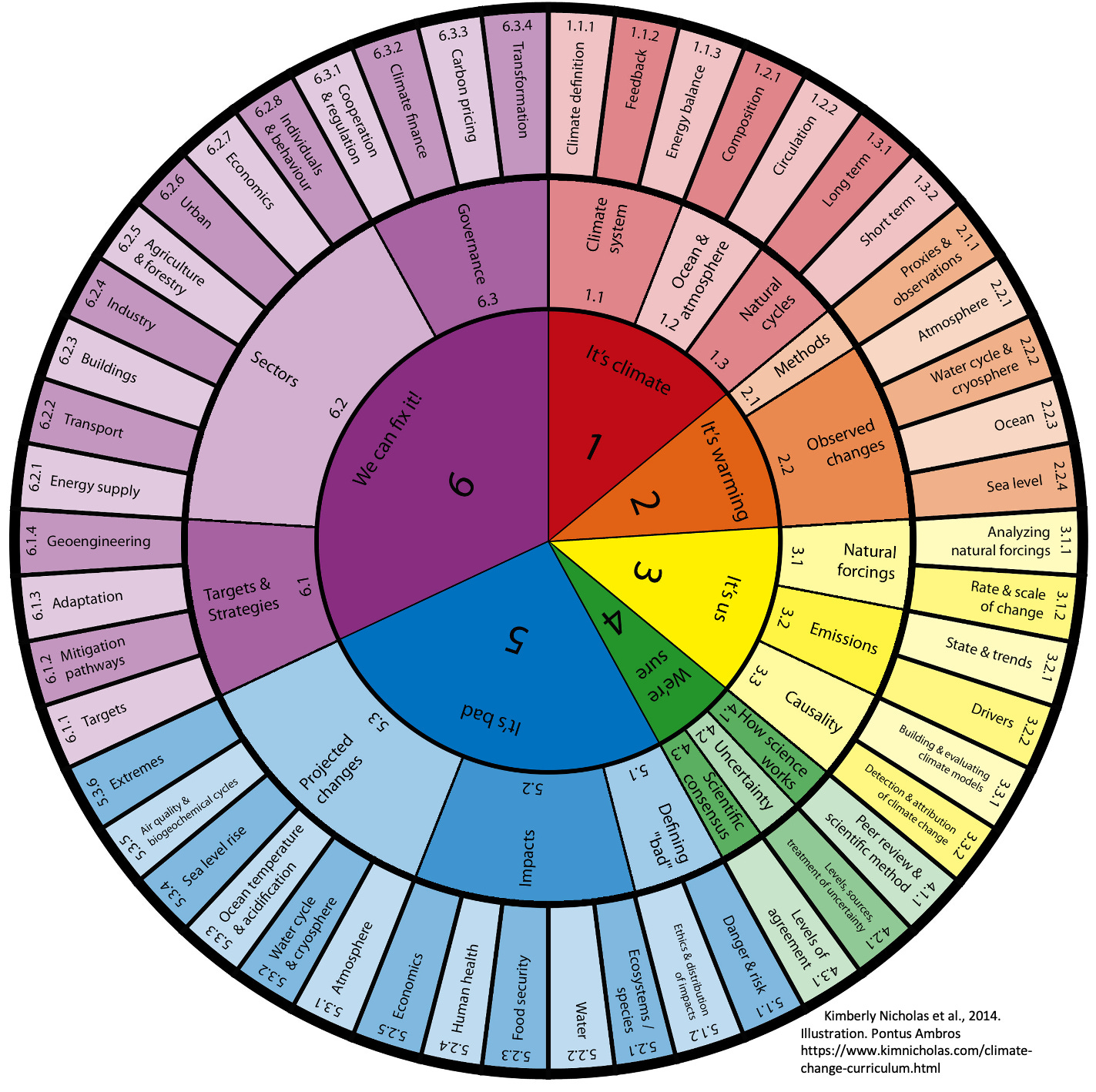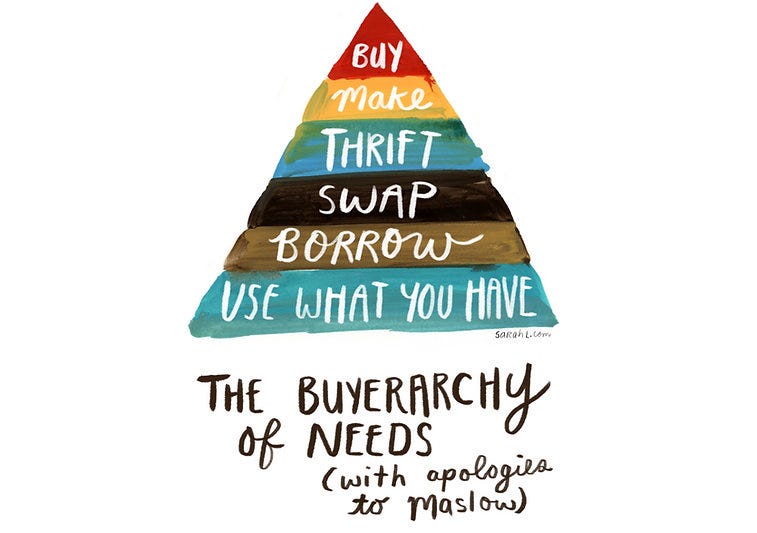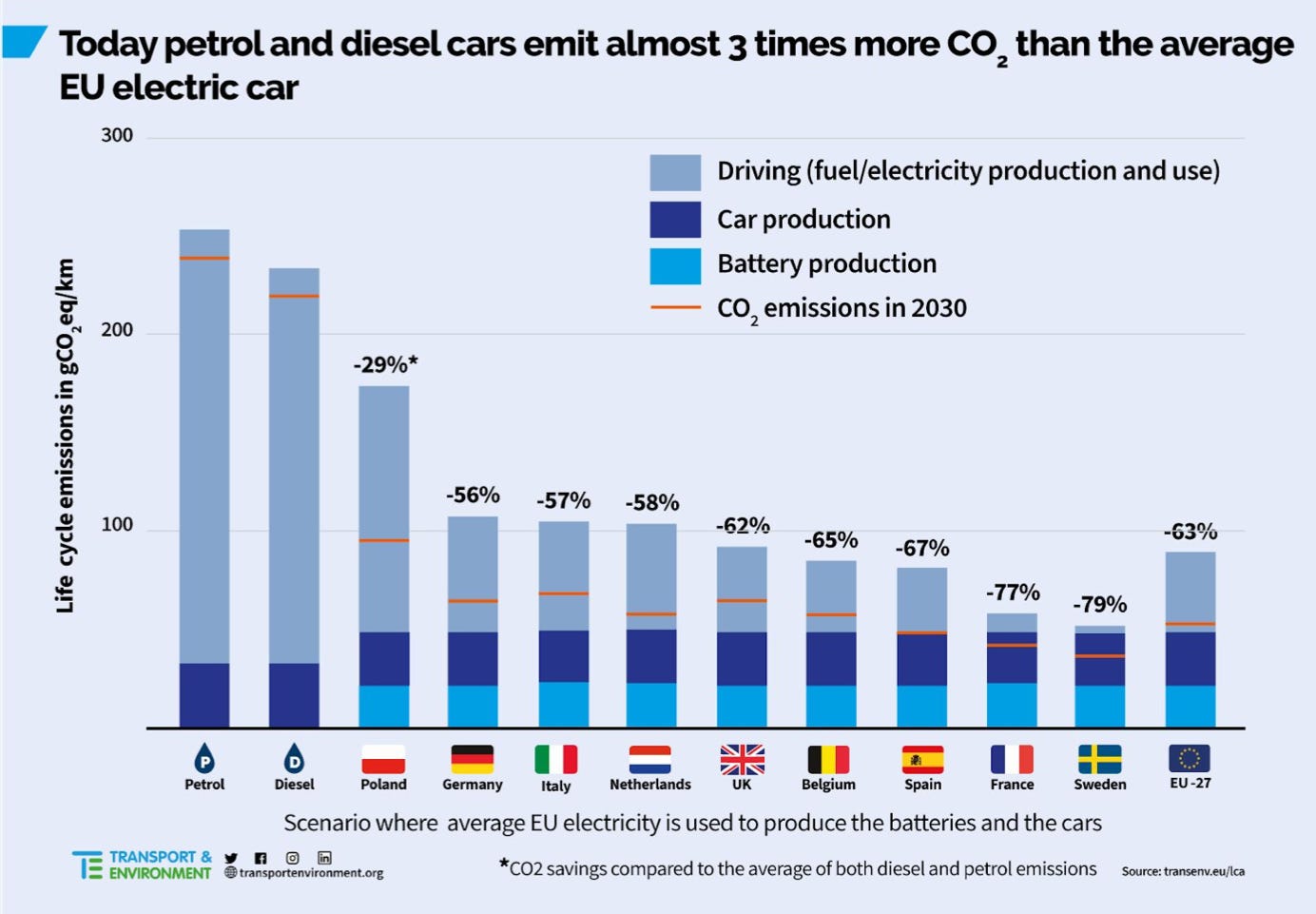The only time buying new is better for climate
Facts: Climate change = bad; Feelings: Beyond self-care to fix the root causes of burnout; Action: The only time buying new is better for climate
Hi friends, times are tough. I hope you’re doing okay.
We need each other now more than ever, and we have two upcoming community events I hope you’ll join:
1. A Climate Discussion Thread right here at We Can Fix It on Tuesday, March 1.
2. A climate conversation on Thursday, March 10, w/ me and my badass former student and climate champion, Shrina Kurani, who’s running for US Congress. Please donate what you can to Shrina’s campaign to defeat an incumbent with a 7% (!) lifetime environmental voting score. More deets here and below!
Hope this newsletter gives you a little boost — and welcome if you’re new. Hang in there!
Facts: Climate change = bad
I know news is very bad right now. I’m sorry to say you need to prepare for more dire headlines on Monday, February 28, when a major new climate report is launching.
I will be hosting a live Discussion Thread for you, lovely We Can Fix It subscriber, where I’ll answer your questions about the new IPCC #ClimateReport, how to deal, and everything else climate-related next Tuesday, March 1st, from 20:00-21:30 Sweden time (find your local time zone). Join by clicking on the link you’ll get in your email at that time (or come straight to the Substack homepage and join from there).
I’ll read the new IPCC report when it’s publicly posted on Monday, but I already know what it will say: climate impacts are really bad, and they will keep getting worse until we stop burning fossil fuels. (Monday’s report is from Working Group II, officially called Impacts, Vulnerability and Adaptation— roughly corresponding to It’s Bad, below.)
Together with a group of masters’ students, I analyzed the previous set of IPCC climate reports in 2014, which we developed into a climate change curriculum based on synthesis science. It’s centered around the “Climate Haiku” framework I’ve used since 2011 (It’s warming, it’s us, we’re sure, it’s bad, we can fix it.) Pontus Ambros made this lovely visual summary:

I expect the updated report next week will have the latest numbers and stronger evidence on what we’ve known for a long time. Basically every study on climate impacts, everywhere in the world, using whatever approach, concludes:
Climate change is harming places and life around the world.
There is some potential for people and nature to adapt to warming, but there are also limits beyond which adaptation is impossible. The faster humans stop burning fossil fuels and thereby limit warming, the more options we have to adapt.
Currently social systems are mostly failing to adapt, and changes are happening too fast for nature to adapt, leading to a lot of suffering. :(
A few resources to keep up your knowledge and courage:
My go-to thread for #ClimateReport days (essentials you need to know, my advice for coping & finding purpose, and what science says you can do that actually makes a difference)
We Can Fix It summary from the last IPCC #ClimateReport in August 2021, focused on the physical science of warming
Great 9-minute video explainer from Dr. Adam Levy (ClimateAdam): Why the IPCC climate reports are so important
See you back here on Tuesday for our Discussion Thread. x
Feelings: Beyond self-care to fix the root causes of burnout
“Burnt-out people aren’t equipped to serve a burning planet.”
-Susi Moser in All We Can Save
Two climate journalists I deeply admire, Emily Atkin at HEATED and David Roberts at Volts, recently shared that they’re taking breaks from writing to take care of their mental and physical health.
I am heartened by the outpouring of love, support, and advice they both received from readers in comments on their posts. (Emily’s fans advocated exercise, rest, and peppermint tea, while David got lots of thumbs-up for yoga, and advice on transcription software and ergonomic setups for typing with severe tendonitis).
We can’t control everything about our health, and we live in a system that magnifies stressors on the vulnerable. Still, we need to do what we can to protect and prioritise our well-being. Climate work, the pandemic, 2022… are hard. They take a toll on all of us. As Emily Atkin wrote:
But I have realized that, without personal resilience, strategies for systemic resilience are meaningless. The people running a system determine its success.
When I started HEATED in the summer of 2019, I was an incredibly resilient person. I had routines, activities, and communities outside of work that kept me energetic and strong, no matter what. Two years into this pandemic, I have lost a great deal of those things, and embarrassingly have not found a way to rebuild them. As a result, my mental health has deteriorated. My brain feels in a constant state of fog and overwhelm.
-Emily Atkin in HEATED
I really appreciate Emily talking about and normalising a shared part of the human experience. While working to make the whole world more safe, fair, and beautiful, we each need strategies to take care of our minds, bodies, and spirits. I loved this wise comment from a reader on Emily’s post:
Remember there are three main ways to contribute to the Great Turning: stopping the bad stuff, bringing the good alternatives to life, and recharging.
-Linda Watson, comment on “On Resilience,” HEATED
A few resources for recharging: I gathered some of my favourite resources for staying well here; this On Being podcast with Christine Runyan has good strategies for restoring a healthy mind-body connection.
Rest and self-care are essential. But if the root of feeling worn down is burnout, they won’t fix the problem.
Burnout is everywhere, but before I read this article by Isobel Whitcomb in Popular Science, I didn’t know exactly what it is.
I learned burnout is always derived from work (unlike depression), and it’s a combination of three things: exhaustion, loss of idealism, and feeling you’re bad at what you do (ugh).
Six factors prevent burnout:
1. Manageable workload
2. Autonomy
3. Fairness
4. Reward for work
5. Strong workplace community
6. Alignment with your values to provide meaning
I like the idea that even if you’re not burned out, you can work on improving these six points to reverse-engineer more meaningful work.
-Me in David Bauer’s Weekly Fillet, “insights that delight a curious mind”
Please take care of your body and mind, and work through the six risk factors for burnout as Isobel Whitcomb describes, to help keep you healthy and in this work for the long haul. <3
Action: The only time buying new is better for climate
What’s the best car for the climate? Trick question: it’s car-free!
Okay, but what if you’re going to have a car anyway? In that case, buying a new electric car is way better than driving your old petrol (gas) or diesel car into the ground.
Surprised? Most of the time, the most sustainable option is to use what you already have— as the wonderful Buyerarchy of Needs by Sarah Lazarovic illustrates. Buying new (and the mining, deforestation, processing, shipping, etc. it entails) should be a last resort for everyday items like clothing, shoes, tools, and furniture.

But! There’s a very important exception to this golden Do Not Buy New rule.
When something burns fossil fuels every time you use it, scrap the old one and get a low-carbon new one as soon as you can afford it.
For many of the items we consume, production causes a lot of its lifetime emissions.
But for things that burn fossil fuels to work, like cars and space/water heaters, production of the physical object itself is a small part of the emissions that its use will generate over its lifetime.
About 12% of the lifetime emissions from a petrol (gasoline) car come from producing the car itself. That means almost 90% of a car’s climate pollution comes from driving it and burning, well, gasoline.
Electric cars and their batteries have a slightly higher carbon cost to produce, compared with a petrol car. But this difference is quickly made up from the emissions avoided while driving it, as this analysis from Transport and Environment shows:

On average, once you’ve driven an electric car for 23,000 km (about 14,000 miles), you have “repaid your carbon debt”. From then on, you’re polluting less than you would have if you kept your old gasoline car. In the best case, where the battery is produced and charged on clean electricity, you’re already on the carbon-positive side in about half that time.
You can use this calculator from Transport & Environment to compare climate pollution from your current car with an electric one.
The cleaner the energy grid where you’re charging the electric car, the lower overall emissions will be. But no matter where you are in the world, electric vehicles are better than fossil-powered ones. (Here’s how Europe, the US, China, and India stack up.)
Actions: When to Buy vs. Hold for Climate
For stuff that doesn’t require fossil fuels to use, like clothes, furniture, and tools, follow the Buyerarchy of Needs: first use what you have, then borrow, swap, thrift, or make. Only buy new what you genuinely need after you’ve pursued those other options.
When it’s time to replace something that runs on fossil fuels, buy a version that does not run on fossil fuels. For heaven’s sake, in the Year of Our Carbon Budget 2022 and beyond, please do not buy any new cars, stoves, heaters, … that run on fossil fuels like gas, petrol, propane, etc.
If you have a car, switch to a fossil-free car as soon as you can. It’s a win for the climate to scrap your old car even before it needs replacing.
DeCARbonize your car first, before your home: If you drive, you will save way more emissions replacing a fossil car with a non-fossil car than with any energy upgrades you can make at home.
Once you’ve deCARbonized (ha!), in terms of home energy upgrades, after switching to renewable energy, the biggest carbon savings come from replacing your fossil-powered home heater with a heat pump.
If you’re fossil-car-free and your heat pump is humming merrily along, and you want to do more replace your gas water heater and then your gas stove with electric ones.
Support organisations and tell your politician you support policies to set a stop date for selling things that run on fossil fuels, including a phase-out (BAN!) on cars with internal combustion engines.
Coltura is working for a gasoline-free America.
In the EU, several countries have set timelines for banning ICE vehicles as soon as 2030, and the Fit for 55 package that aims to allow only zero-emission vehicles from 2035 is now in progress.
NGOs including Transport & Environment in the EU and Possible in the UK are campaigning for sustainable transport, including getting rid of fossil cars.
Shout-out to We Can Fix It readers Anna S., Jennifer, and Anna B. for inspiring this month’s actions!
Upcoming Events
Remember my advice from April 2021 (based on this study):
if you have money to spend on climate action, don’t buy offsets. Donate it to politicians running on a strong climate platform, especially supporting scrappy challengers against incumbents with a bad climate voting record early in the election cycle in close races.
Well here is your chance to do exactly that! Climate champion and my brilliant former student, Shrina Kurani, is running for US Congress, against a long-time incumbent with a terrible 7% lifetime environmental score, in a district that’s newly competitive. Please donate what you can to support Shrina’s campaign, and join our event on March 10. (Note you must be a US citizen or green card holder to contribute to American elections.) Thank you!
Kim on the Interwebs
I spoke w/ Steve Lamb about being a good ancestor on Impact Adventures. Listen:
Recently Enjoyed:
Reading Parenting in a Changing Climate, by Elizabeth Bechard, felt like a heart-to-heart with a wise friend. This beautifully written book is welcoming and galvanising. Check out my Goodreads highlights and get your own copy!
Turmeric-Black Pepper Tofu with Asparagus, by Ali Slagle, was super quick & tasty.
Take care friends!
xo, Kim
P.S. I heard from Linda that the color scheme I’d been using for these posts was hard to read. I’m sorry! What do you think of this new one?? LMK!




Wow, I'm surprised about this. My partner's car is 25 years old. It's a small car, a Peugeot 106, so it has a small engine and it's light, so it's rather fuel-efficient. It was one of the first to be fitted with a catalytic converter so it continues to pass its MOT. The reason it's still running is that we don't use it very often, maybe once a month or so. Our plan is to perhaps go car-free at some point, especially as we're moving to a new apartment which doesn't have a garage. But would you say that the advice to scrap the old car and switch to electric applies in our case? Car-free or car pooling/renting etc makes more sense I feel. But also given how infrequently we use it, it seems silly to get an electric car!
A case can be made for holding on to the fossil fuel car if you drive it only occasionally after transitioning to almost always walking, bicycling... A fossil fuel car that is seldom driven generates little greenhouse gas emissions. A fossil fuel that is not being replaced, eliminates or postpones the upfront carbon of a replacement car.
Also, if you have an EV, consider that less driving is provides an important benefit - uses less electricity. We are all on widespread electric grids that have insufficient green electricity to meet all needs. Electricity not used means either nongreen electricity not used, or green electricity that can be made available to be used in place of nongreen electricity.
I'm 77 years old. I was pleasantly surprised how well my manual bicycle met my needs as I transitioned completely away from using an automobile between 2017 to 2020. Since 2020 I average about 3 miles a day on my manual bicycle in Seattle (I walk up the steep hills pushing the bike). My longest roundtrip bicycle ride to date Is about 20 miles - it was easy. I was also pleasantly surprised how much cargo I could carry once I added a cargo basket (with a long strap to lash down the cargo) to the back of the bicycle - that's in addition to cargo in my backpack and in bags over my wrists. Bicycling on the sidewalk is legal in the State of Washington (make it legal everywhere), so I do most (but not all) of my bicycling on the sidewalk to distance myself from automobiles.